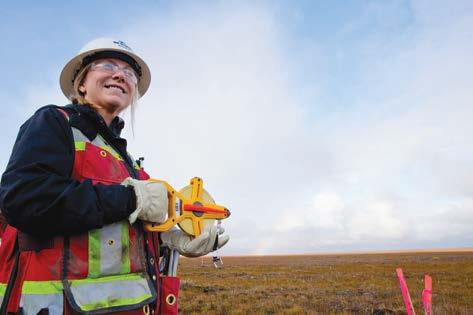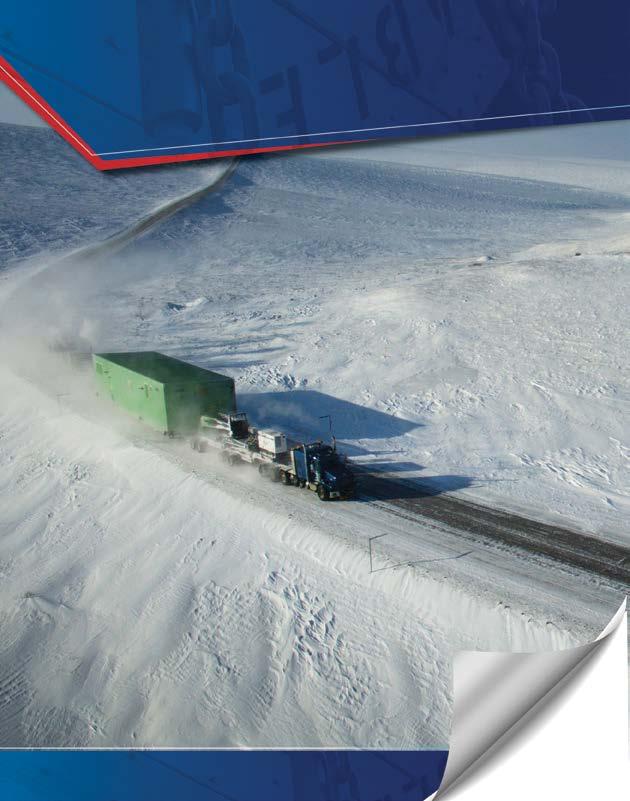
7 minute read
VIRUSES AND VOLATILITY
Stabilizing oil prices and the ebbing pandemic are good news for the North Slope
By Melissa Bannigan
North Slope workers fly in to work on a Boeing 737 owned by one of the borough’s largest oil producers and then spend two weeks working 12- to 16-hour shifts while living in camps alongside their coworkers. Or that used to be a standard operating procedure before the worldwide pandemic.
So what happened in 2020 on the North Slope, where people live and work in close, communal environments and a novel coronavirus pandemic forced everyone to take a little more space?
Alaska’s oil and gas industry is accustomed to the yo-yoing of economic cycles, but COVID-19 was a whole new issue to bounce back from. It caused companies to quickly reassess and implement new safety measures, such as mandating health check-ups for employees before they could travel to various locations from Fairbanks or Anchorage.
And even despite taking new precautions, a worker at Prudhoe Bay tested positive for COVID-19 in March 2020, becoming the first person to get struck by the illness in the oilfields on the North Slope. After the worker at Prudhoe Bay tested positive for COVID-19, it was clear that North Slope operators needed to do more to protect critical workers.
ConocoPhillips immediately paused flights of its rotation crew between Anchorage and the Kuparuk and Alpine fields for two weeks. BP continued operating flights to Prudhoe Bay, which it operated at the time, but scaled back non-essential operations. The company also conducted pre-flight health screenings for all employees.
Even as companies operating on the North Slope prioritized safety, economic realities meant they needed to focus not only on preventing their employees from contracting COVID-19 but on whether they could even continue employing all of their workers.
Because while a positive test definitely wasn’t positive news for North Slope operators, it wasn’t their introduction so the problems the pandemic would offer. Oil and gas prices dramatically dropped in February: triggered by disagreements over oil production costs between Russia and Saudi Arabia, crude prices crashed 65 percent during the first quarter of 2020. This prompted an oil glut, forcing producers around the world to scale back production.
Between the fluctuating price of oil and a need to protect workers, the North Slope tightened operations and reduced its workforce, and multiple rounds layoffs took place as oil operations adjusted. In February 2020, the total labor force on the North Slope was 3,900: a year later, it was down to 2,982.
Various Costs

that it would immediately cease drilling any new wells. By the end of the month, the behemoth producer announced it would cut oil production in Alaska by about 100,000 barrels a day due to plummeting prices.
And it wasn’t just ConocoPhillips that was suffering. Schlumberger’s first quarter revenue of $7.5 billion decreased 5 percent year-on-year, while its year-on-year revenue in North America sank a dismal 17 percent as drilling activity declined. To preserve cash, the company cut its dividend by 75 percent. Salaries were cut, and the company then took what it saw as a necessary step to close facilities and furlough personnel.
In fact, Schlumberger was just one of many oilfield service companies, including Peak Oilfield Service, Baker Hughes, and Halliburton Energy Services, to send notice to the state announcing job cuts.
Over the course of the year, news of layoffs kept trickling in, and employees have continued being cut in 2021. In February, ConocoPhillips announced plans to lay off or give voluntary severances to 95 of its workers. It’s not clear how many of these employees worked in Anchorage or on the North Slope, but what is clear is that a year after the pandemic began, all activities, from production to employment, are still being impacted.
Sustainability
Partnership – Energy - Excellence

And that’s distressing news for the entire state. According to the Resource Development Council, “The oil industry accounts for one-quarter of Alaska jobs and about one-half of the overall economy when the spending of state revenues from oil production is considered. In other words, without oil, Alaska’s economy would be half its size.”
One of Alaska’s other major industries, tourism, was also devastated by the pandemic. Unfortunately for many tourism-based Alaska companies, 2021 will present another difficult season as cruise ships will not return and easing travel and other restrictions likely cannot occur quickly enough to carry them through another rough year.
So it’s not surprising that, for a variety of reasons, in March 2020 the state classified oil and mining as essential industries, allowing them to mitigate as much as possible the dangers of the pandemic while remaining in operation.
Rather than working two weeks on, two weeks off, shifts were extended to twenty-one days to allow workers to safely quarantine. But these stricter safety measures couldn’t mask the fact that, even with another week tacked onto shifts, the North Slope’s biggest industries would need to continue production with a pared down workforce.
Of course it has affected the profitability of the North Slope. Compared to a profit of $2.8 billion for the second quarter of 2019, in the second quarter of 2020, BP (which was still operating Prudhoe Bay at the time) had an underlying replacement cost loss of $6.7 billion. Other companies faced similar losses.
A Year Later
In March, Alaska’s Revenue Department published a Spring 2021 update to its official Fall 2020 Revenue Forecast. The report includes the Department’s forecast of oil prices, oil production, and state revenue. For FY2020, oil prices on the North Slope averaged $52.12 per barrel. On an upward trajectory, the forecast for 2021 is $53.05 per barrel and $61 per barrel for 2022. Although drilling and pricing were both reduced in 2020, “over the coming decade, the forecast represents a lower expected decline rate for the larger currently producing fields as well as an improved outlook for new developments due to higher oil price expectations.”
As markets make their slow recovery, Alaska may see a rosier picture because of higher oil prices and increased production.
In 2021, it looks like two major projects may begin on the North Slope that could increase new production through the Trans Alaska Pipeline System by 200,000 barrels per day by 2025.
ConocoPhillips is nearing the start of Front End Engineering and Design (FEED) on its Willow project in the National Petroleum Reserve-Alaska. A decision on this potentially $6 billion development should be made by the end of the year.
And Oil Search, with minority partner Repsol, is still working on developing the Pikka project. Oil Search would like to launch final engineering on the project soon.
Projects such as these benefit the state in large part through the creation of jobs, and fortunately Alaska has led the country in many ways in reducing COVID-19 counts and distributing vaccinations. As of early April, almost a third of Alaskans had received their first vaccination shot and more than onefifth had been fully vaccinated.
Governor Mike Dunleavy said in April, “If we keep up this brisk pace of vaccinations, we will soon get to the point where further spread of the disease will become unlikely. I thank those individuals who have worked hard to get us to this point and encourage Alaskans to keep it up. Because of efforts made by all Alaskans, we are seeing healthier communities and a healthier economy.”
As of publication, Alaska plans to enter Phase II of its reopening plan on May 22. This will allow the state to resume certain economic activities statewide and on the North Slope. Under phases I and II, oil and gas companies needed to come up with creative strategies to keep its employees safe, including only maintaining its essential workers. However, Under Phase II all businesses will be able to open at 100 percent capacity.
In one of the world’s most challenging energy centers, the pendulum appears to finally be swinging back toward profitability. For the employees who travel to this remote borough for work, the reopening of Alaska, and indeed, the entire country, will offer increased stability as they once again live and work in the camps on the oilfields.
Governor Mike Dunleavy











